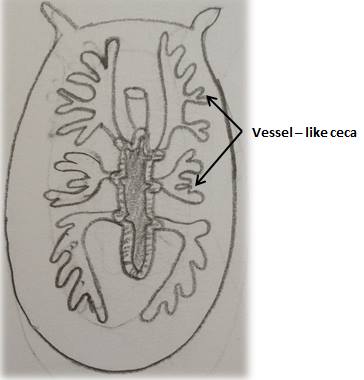Digestive System
Turbellarians have a blind gut and the mouth (pharynx) is used for both ingestion of food and excretion of waste. The wall of the gut is single-layered and consists of phagocytic and gland cells.
Larger turbellarians such as Pseudobiceros bedfordi have a highly branched gut (ceca = lateral branches) that extends to the margin of the body (Figure 1). This allows nutrients to diffuse to their tissues. (Ruppert et al., 2004). The gut is lined with cilia and the transport of nutrients occur via ciliary currents. (Barnes et al., 1988).
Digestion is partially extracellular and partially intracellular. Nutrients diffuse into the body and circulates body tissues via cells . There is no circulatory system. The waste products diffuse out of the body via a simplified protonephridial (kidney)system (Figure 1).

Figure 1. Vessel-like ceca of the gut in a polyclad
Polyclads have a highly branched gut ( ceca= lateral branches) that extends to the margins of the body.
|